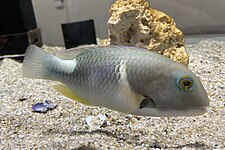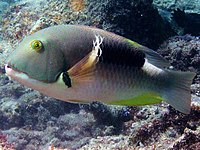Orange-dotted tuskfish
| Orange-dotted tuskfish | |
|---|---|

| |
| Scientific classification | |
| Domain: | Eukaryota |
| Kingdom: | Animalia |
| Phylum: | Chordata |
| Class: | Actinopterygii |
| Order: | Labriformes |
| Family: | Labridae |
| Genus: | Choerodon |
| Species: | C. anchorago
|
| Binomial name | |
| Choerodon anchorago (Bloch, 1791)
| |
| Synonyms[2] | |
The orange-dotted tuskfish (Choerodon anchorago) is a species of wrasse native to the Indian Ocean from Sri Lanka eastward to French Polynesia in the western Pacific. Its range extends north to the Ryukyus and south to New Caledonia. It inhabits reefs at depths from 1 to 25 m (3.3–82.0 ft). This species can reach a length of 50 cm (20 in). It is commercially important, and can be found in the aquarium trade.[2]
Potential tool use
[edit]A orange-dotted tuskfish named Percy starred in the first episode of BBC's Blue Planet II. Filmed at the Great Barrier Reef, Percy, who was female at the time, was filmed repeatedly breaking open clams by carrying them to a specific group of hard coral termed by filmmakers as a 'castle', and then striking the clams against a specific patch on the coral until they crack.[3] The same behaviour has been documented in individuals from Palau. The related blackspot tuskfish and a few other wrasse species, have been recorded exhibiting similar behaviour, which is potentially a form of tool use by animals.[4][5][6]
Gallery
[edit]-
At Raja Ampat, Indonesia
-
Juvenile, in captivity
References
[edit]- ^ Shea, S.; Liu, M. (2010). "Choerodon anchorago". IUCN Red List of Threatened Species. 2010: e.T187578A8573421. doi:10.2305/IUCN.UK.2010-4.RLTS.T187578A8573421.en. Retrieved 20 November 2021.
- ^ a b Froese, Rainer; Pauly, Daniel (eds.). "Choerodon anchorago". FishBase. August 2013 version.
- ^ Nature, Research Communities by Springer (2017-10-31). "Tools and tails on Blue Planet II". Research Communities by Springer Nature. Retrieved 2025-01-11.
- ^ Honeyborne, James. "Blue Planet II: Seeing a fish use a 'tool' for the first time was remarkable". Penguin Group. Retrieved January 20, 2018.
- ^ Balcombe, Jonathan (June 1, 2016). "Fishes Use Problem Solving and Invent Tools". Scientific American. Retrieved January 20, 2018.
- ^ Bernardi, G. (2012). "The use of tools by wrasses (Labridae)". Coral Reefs. 31 (1): 39. doi:10.1007/s00338-011-0823-6.
External links
[edit]- Photos of Orange-dotted tuskfish on Sealife Collection





